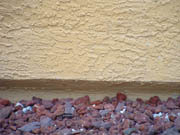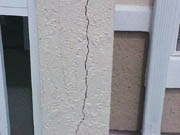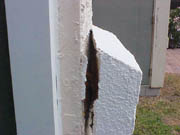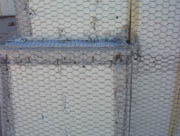This article addresses problems with one-coat stucco that are caused by well-meaning professionals. These professionals may be architects, builders, contractors or stucco applicators. None of these professionals would knowingly do anything to degrade the stucco's quality but in pursuit of that elusive goal called profit, "short cuts" are taken. Since "short cut" is considered a politically incorrect word by some, maybe we should refer to these techniques as "creative profit-generating technology."
Regularly, when problems develop, the builder or the architect states that the one-coat manufacturer should have provided regular inspections of the job and provided assurances that the job was progressing without problems. One-coat manufacturers are not registered architects or registered engineers and as a result are not in a position to provide architectural or engineering advice. The structure behind the one-coat stucco is mandated by the evaluation services. The evaluation reports state that the one-coat manufacturer's product can be used if it is used in a specified way. It is the responsibility of the architect, engineer, builder, contractor and applicator to follow those mandates. If the one-coat manufacturer is to provide inspections and assurances, where do the inspections start? Would one expect the one-coat manufacturer to examine soil tests and provide engineering assistance to ensure that the foundation drawings were based on the soil conditions and then inspect the pouring of the foundation? Foundation failures cause one-coat stucco to crack.
Stucco-and this includes both one-coat and three-coat-is not a structural product. It should not be expected to hold together a building that has defects. If poor construction practices are followed, stucco will provide a canvas to illustrate the poor construction practices. This does not mean that the stucco failed but that the building failed and the stucco showed the failure. Many "stucco problems" are the result of someone being told to do their work prior to the building being ready for their trade and failure to respond in writing that the building is not ready.
Following is a list of steps that various well-meaning professionals periodically take to generate that elusive profit. At other times these items slip through due to overwork.
1. Structure is under-designed.
Stucco is not a structural component and should not be expected to hold a building together. If there are foundation problems or if there is inadequate beef to columns and beams or other structural members, movements will occur and the stucco will crack. Cracks that are caused by foundation failures are usually angle cracks and they usually start at a corner of a window or door. There are other types of cracks (mentioned later in this document) that are the result of the framework of the building moving.2. Wood sheathing is not gapped.
If the wood picks up moisture from higher humidity or from water intrusion, the wood sheathing will expand. This will cause several problems. They include but are not limited to stress cracks in the stucco, especially between framing members, and very ragged cracks along the edges of the sheathing sheets. This can also cause sheathing to buckle, leaving voids behind the stucco. If an adequate weather-resistive barrier is installed, water that may penetrate through the cracks in the stucco will exit along the weep screed rather than penetrate into the sheathing. If an adequate weather-resistive barrier is not installed, additional water will come in contact with the wood sheathing and cause more problems. In some markets, more than 95 percent of the wood sheathing is not gapped, even though every piece of wood sheathing has a statement printed on it requiring gapping.3. Inadequate flashing.
Flashing that is designed but not installed is flashing that will not function. Flashing should be installed as if there were no sealants to assist the flashing, since the sealants will sooner or later fail. Kick-out flashing should be used to ensure that water does not flow from a roof onto a wall surface.
4. Inadequate weather-resistive barrier is specified or applied.
Stucco is not a water barrier. There are stuccos that tend to resist the penetration of water and others that are less likely to resist the penetration of water. Because stucco is not a water barrier, codes mandate a weather-resistive barrier.The weather-resistive barrier may be inadequate in a number of ways. If polyethylene sheeting is used rather than a vapor-permeable sheeting, vapor can condense on the sheathing or other components and contribute to mold growth. If a weather-resistive barrier that is torn is used, it will leak. If the weather-resistive barrier has staples in it, it will leak. The more staples, the more leakage. If the weather-resistive barrier is not lapped and taped correctly around windows and doors, it will leak. If the weather-resistive barrier is installed by untrained personnel, it will leak. Some lathers cut the lath at corners. If the weather-resistive barrier consists of the paper on paperback lath, a vertical seam that has no weather-resistive barrier is established. This will leak.
Most jurisdictions require the equivalent of two layers of Grade D building paper over wood sheathing. Many jurisdictions in Florida require only one layer of Grade D paper and we regularly hear that the code requires only one layer and "we will not go beyond what the code requires." We have seen this even when the job specifications mandate a house wrap plus paperback lath. Whether mandated by code or not, two layers of weather-resistive barrier should be applied. If building paper is not adequately lapped or lapped in reverse, leaks can occur. The lower end of weather-resistive barriers should terminate on the exterior side of flashing.
Not all weather-resistive barriers are equal. Many standards call for a minimum of one layer of Grade D building paper over non-wood substrates or a minimum of two layers of Grade D building paper over wood substrates. Grade D building paper is easier to damage and harder to repair than some of the modern house wraps. If Grade D building paper is used as the only weather-resistive barrier, extreme care must be exercised that the barrier is not compromised. Remember, even the best weather-resistive barrier will fail if installed incorrectly.
5. Lath is attached to the sheathing between framing members to keep the lath flat.
Each time a staple goes through a weather-resistive barrier, whether it is Grade D building paper or the best house wrap, the chances of a leak occurring are increased. The custom of randomly stapling the lath to the sheathing results in excess penetrations. The excuse for the excess staples is to "keep the lath tight." If the sheathing buckles in, the stucco will be cracked or the staples will be pulled. With excessive holes in the weather-resistive barrier, there is a great likelihood that water will penetrate the barrier and cause the wood sheathing to buckle. By compromising the barrier, water can penetrate to the sheathing and mold problems can develop. Lath is kept tight by pulling it tight before staples are added. The process worked from the time metal lath was invented until pneumatic staplers became common tools for lathers. Mandate that reasonable care be taken and limit the number of staples that are used on a job.
6. Non-self-furring lath is used.
Lath is a hanger for stucco. If lath is not furred out, the stucco may not key into the lath and as a result will be more likely to sag or slough off. Additionally, if the lath is not furred out, the reinforcing of the stucco is on the back of the stucco panel rather than slightly into the stucco. Even though the major function of lath is to act as a hanger, not to act as reinforcing, inappropriate positioning of the lath produces stucco that is more likely to crack if the sheathing bulges, if the studs move, if the stucco is subject to negative wind loading or if the stucco is subjected to impact.7. Hanging lath upside down.
The usual reason for hanging lath upside down is that a lathing contractor saved a little money by not training the crew. This is a problem for the stucco applicator, not a long-term problem. Diamond mesh lath, when hung right side up, provides little pockets to hold lath and provides support while the initial coat dries. If hung upside down, the stucco will tend to slough off. After the lath has been wet with stucco and allowed to dry, there is enough texture to allow the stucco to grab the lath. If lath is hung upside down, there are usually other lathing problems because the lathers have not received adequate training.
8. Failure to provide adequate lapping of lath.
If paper-backed lath is lapped paper-to-paper and lath-to-lath (correct), it will be thinner than if it is lapped in any other manner. Lapping it incorrectly will result in an area where the stucco is thinner and thus more likely to crack. Butting lath pieces results in a weak area in the stucco. If there are any movements of the structure, a crack will occur in that weak area. Handling lath so that the edge of the lath is folded out results in a thin area of stucco and can result in a crack. If lath is laid without staggering the sheets, there will be areas of four layers of lath rather than the normal maximum of three layers of lath. This results in thinner stucco and a greater potential for a crack to develop.As long as lathing starts at the bottom of the wall and there are adequate end laps, poor lapping practices with paper-back lath usually do not result in water penetration. Water penetration, if it occurs, is usually related to penetrating the weather-resistive barrier with excessive staples or inadequate end laps.
A separate problem that is periodically identified as a lath-lapping problem is "scaffold board syndrome." The scaffold boards interfere with stapling the lath to the framing, so where a scaffold board is located, staples are missing for 12 to 15 inches. This results in a meandering crack at that height.
9. Failure to provide adequate weep screed detailing.
If there is a barrier at the bottom of a stucco panel that will prevent the discharge of water, water problems will develop. Weep screeds are designed to allow the discharge of water, but improper selection of weep screeds can lead to additional problems. If the bottom of the sheathing is exposed behind the bottom of a stucco panel (when mudsill is even with the edge of the foundation), water and vermin problems may develop. Water may splash up onto the sheathing and start its deterioration. Ants, mice, rats, snakes, bees, wrens, and other animals can enter walls through deteriorated sheathing behind improperly selected weep screed.
There are a number of weep screeds on the market. Depending on the location of the mudsill in relation to the edge of the foundation and on the sheathing selected, different weep screeds and flashing must be selected and used. Failure of the architect to specify this detail will often result in problems. If the architect does specify this detail, problems may still develop if the slab is not poured as designed. Caulking the bottom of the sheathing when the sheathing extends beyond the foundation to keep out vermin often results in water and mold problems.

10. Failure to adequately address control joints and expansion joints.
Expansion joints are placed in stucco where there is an expansion joint in the structure of the building. These are joints that allow the different parts of the building to move independently. Those familiar with building with block, brick and concrete are familiar with expansion joints. Lath should never be continuous at expansion joints. There will be movement at an expansion joint and if the lath is continuous over the area or if the expansion joint in the stucco is omitted, a crack will develop. Usually, the crack will be major. Repairs, short of installing an expansion joint, will result in more cracking.Control joints are used to divide the stucco into panels in a manner so that cracking will be controlled. Common places for inclusion of control joints are above and below window openings, above door openings, and along sill plates. When control joints intersect, the vertical control joint should be continuous and the horizontal control joints should be cut. This allows any water flowing behind the control joint a greater chance of escaping.
There are schools of thought that make all other comments concerning control joints controversial. Traditionally, the weather-resistive barrier was not attached to the lath, control joints were loosely installed and lath was laid over the flanges of the control joint and wired in place. This process was very effective but time-consuming and thus expensive. This allowed the control joint to move and with a weather-resistive barrier behind the control joint, the area remained watertight. An improvement was to lath the field with paper-backed lath, cut the lath but not the paper and wire the control joint to the lath. This system functioned well. In recent years, based on a rush to complete buildings at lower costs, standards have been developed that allow the control joint to be mounted on top of uncut lath. Part of the justification is that with paper-backed lath becoming very common on jobs, cutting the paper-backed lath results in a direct conduit for water to pass to the sheathing. This sounds like a reasonable justification if the only weather-resistive barrier is the paper on the paper-backed lath.
Hard stapling of control joints to the framing converts control joints into screed points and nothing else. When this occurs, the stucco on the flanges of the control joints is thinner than the rest of the stucco in the panel. If movements occur and control joints are placed where movement is anticipated, cracking occurs over the flanges of the control joints. Stapling the lath into place and then stapling the control joints into place will result in numerous penetrations of the weather-resistive barrier behind the control joint. This leads to water penetration. Caulking the control joint usually does not correct the problem. It is almost impossible to keep water from penetrating to the sheathing with hard-stapled control joints over lath when the weather-resistive barrier is one layer of Grade D building paper.
In most evaluation reports the design of the control joint system is the function of the architect, design professional or engineer. In some reports, if these professionals do not design the system, ASTM C1063 becomes the controlling document. The one-coat manufacturer and the applicator are usually not included in the list of responsible parties in designing the control joint system.
11. Stucco has been applied too thin or too thick.
One-coat stucco evaluation reports usually specify a minimum thickness of 3/8 inch. This is not a nominal thickness of 3/8 inch. This is not 3/8 inch plus or minus 1/8 inch. Three-eighth inch is the thickness that is necessary to encapsulate diamond mesh lath. In areas where stucco netting is used, it is possible to apply stucco thinner and still cover the lath. This has resulted in a request by several applicators for changes in the thickness requirements. We do not know of any evaluation reports that allow less than 3/8-inch stucco for one-coat stucco on lath.In areas exposed to salt air, galvanized lath needs to be protected. This can be accomplished by a layer of stucco or by a high-quality elastomeric coating. We do not know of any statements by the manufacturers of metal lath as to their recommendations concerning the minimum cover over the lath in salt air areas. There is a move towards plastic lath in areas exposed to salt air.
Most evaluation reports mandate that if 20 gauge woven wire lath is used, the thickness of the stucco not be more than 1/2 inch thick. For any lath heavier than the 20 gauge woven wire lath, applying the stucco too thick is not an issue except that sagging may occur or plastic shrinkage cracks may occur if the surface skin cures before the internal portion of the stucco.
This article has reviewed 11 problems that are caused by well-meaning professionals. Remember that one-coat stuccos, when applied correctly, are one of the least expensive and most durable wall treatments available.

Report Abusive Comment